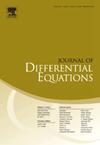High-order asymptotic expansion for the nonlinear Klein-Gordon equation in the non-relativistic limit regime
IF 2.3
2区 数学
Q1 MATHEMATICS
引用次数: 0
Abstract
This paper presents an investigation into the high-order asymptotic expansion for 2D and 3D cubic nonlinear Klein-Gordon equations in the non-relativistic limit regime. There are extensive numerical and analytical results concerning that the solution of NLKG can be approximated by first-order modulated Schrödinger profiles in terms of , where v is the solution of related NLS and “” denotes the complex conjugate. Particularly, the best analytical result up to now is given in [20], which proves that the norm of the error can be controlled by for -data, . As for the high-order expansion, to our best knowledge, there are only numerical results, while the theoretical one is lacking.
In this paper, we extend this study further and give the first high-order analytical result. We introduce the high-order expansion inspired by the numerical experiments in [24], [15]: where w is the solution to some specific Schrödinger-type equation. We show that the estimate of the error is of higher order for -data, . Besides, some counter-examples are given to suggest the sharpness of this upper bound.
非相对论极限区非线性Klein-Gordon方程的高阶渐近展开式
本文研究了二维和三维三次非线性Klein-Gordon方程在非相对论极限域中的高阶渐近展开式。大量的数值和分析结果表明,NLKG的解可以用ε ε2v+c.c表示的一阶调制Schrödinger曲线近似。式中,v为相关NLS的解,“c.c.c”为复共轭。特别是[20]给出了迄今为止最好的解析结果,证明了对于hx α-数据,α∈[1,4],误差的Lx2范数可以用ε2+(ε2t)α4来控制。对于高阶展开,据我们所知,只有数值结果,缺乏理论结果。在本文中,我们进一步推广了这一研究,并给出了第一个高阶解析结果。在[24],[15]中引入了高阶展开:ε ε2v+ε2(18e3itε2v3+eitε2w)+c.c。,其中w是某个特定Schrödinger-type方程的解。我们证明,对于hx - α-data, α∈[4,8],误差的Lx2估计具有高阶ε4+(ε2t)α4。此外,还给出了一些反例来说明这个上界的锐性。
本文章由计算机程序翻译,如有差异,请以英文原文为准。
求助全文
约1分钟内获得全文
求助全文
来源期刊
CiteScore
4.40
自引率
8.30%
发文量
543
审稿时长
9 months
期刊介绍:
The Journal of Differential Equations is concerned with the theory and the application of differential equations. The articles published are addressed not only to mathematicians but also to those engineers, physicists, and other scientists for whom differential equations are valuable research tools.
Research Areas Include:
• Mathematical control theory
• Ordinary differential equations
• Partial differential equations
• Stochastic differential equations
• Topological dynamics
• Related topics

 求助内容:
求助内容: 应助结果提醒方式:
应助结果提醒方式:


